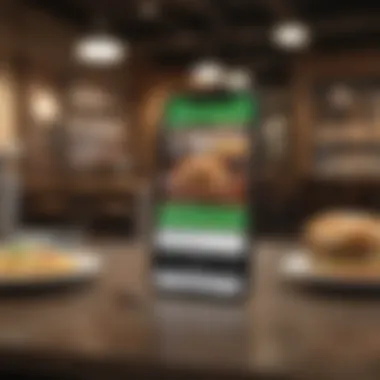Paying for Food with Cash App: Your Complete Guide


Intro
The digital economy is reshaping how we handle everyday transactions. Cash App has emerged as a notable player in the realm of digital payment solutions, particularly in food purchasing contexts. Understanding how to use Cash App for food payments encompasses not just the method of transaction but also the practical implications it has for personal finances. This guide aims to enlighten readers on various aspects of using Cash App in this specific area, highlighting its benefits, limitations and offering practical tips for effective use.
Understanding Personal Finances
Managing personal finances effectively is crucial in any daily transaction. By adapting budgeting techniques, you can assess how much you are able to allocate for food expenses and thereby enhance financial discipline. Here are some essential budgeting techniques:
- Determine Monthly Income: Understand what is your total monthly income after taxes. This will clarify your spending limits.
- Prioritize Expenses: Essential food expenses should take precedence in your budget allocation, followed by non-essentials.
- Set Limits: By categorizing your spending, you are more likely to stay under budget.
Next, tracking expenses becomes imperative. With Cash App, you can gain greater insight into how much you spend on food purchases over time. You might consider:
- Utilizing Transaction History: Review historical data available in the application to reflect on your spending habits.
- Daily Journaling: Manually track expenditure can provide a clearer picture of daily habits.
Finally, setting financial goals is a key component of sound finances. Defining clear goals helps orient your budgeting decisions and daily spending behavior toward achieving larger objectives. It can mean saving for a particular item, aiming for a smart device, or enhancing food quality.
Practical Application of Cash App for Food Purchases
Cash App allows users to seamlessly purchase food from various dining outlets. To maximize convenience, here are essential steps:
- Add Payment Method: Once you have Cash App set up, ensure that you have linked a bank account or debit card for transfers.
- Search for Participating Restaurants: Many businesses accept Cash App payments. A simple search will help.
- Conduct Payment: Simply scan the QR code at the restaurant or take a receipt; both options are accessible with Cash App.
It’s extremely vital to keep in mind the transaction limits and fees associated with Cash App. While it is relatively straightforward to make payments, restaurants may apply a surcharge, particularly for smaller transactions.
Prelude to Cash App for Food Payments
In today's fast-paced world, digital payment solutions have become more than a convenience; they are a necessity. Cash App has emerged as a popular platform for individuals seeking efficiency when paying for food. It is crucial to explore this tool's application within dining scenarios. From paying at restaurants to utilizing various delivery services, understanding how Cash App operates in these contexts is essential for maximizing its benefits.
Understanding Cash App's Functionality
Cash App offers users a seamless method for transferring funds and making payments. Users can link their bank accounts or credit cards, and funds can be sent or received with just a notification. This immediacy allows for faster transactions compared to traditional methods such as cash or checks. Moreover, Cash App incorporates sophisticated security measures, including two-factor authentication and encryption, ensuring user data remains secure during transactions.
Key features of Cash App include:
- Instant transfers between users.
- The ability to hold funds within the app as a digital wallet.
- Options for investing in stocks or Bitcoin.
This versatility makes it popular not just for food payments but other purchases as well. However, proficiency with this app can further enhance spending experiences, particularly when dining out.
The Growth of Mobile Payments
The rise of mobile payments marks an important trend in financial transactions. Consumers are increasingly favoring these solutions over cash or physical cards. Reasons for this shift range from speed and convenience to improved budgeting capabilities. Reports indicate that the mobile payments sector has witnessed substantial growth recently, as smartphone penetration and app adoption have surged.
Several factors have fueled this evolution:
- Increased smartphone ownership among younger demographics.
- The pandemic, which accelerated the normalization of contactless payments.
- Merchant adoption of apps like Cash App enhances consumer confidence in mobile payment platforms.
Recognizing this trend leaves consumers better equipped to navigate the landscape of modern food purchasing, positioning them to take full advantage of available digital payment solutions.
Setting Up Cash App for Food Purchases
When considering the integration of Cash App into your dining habits, it is essential to understand the setup process. This phase is not merely a procedural formality; it is the foundation upon which effective and seamless transactions rest. Understanding how to set up Cash App for food purchases makes the experience easier and assures higher convenience and security.
Creating an Account
To start using Cash App, one must first create an account. This process is straightforward yet crucial. Begin by downloading the Cash App from your mobile device's app store. Once installed, open the app and follow the prompts to enter your email or phone number. After submitting this information, Cash App will send a confirmation code, which you need to enter to verify your identity.
After verifying your identity, you will be guided to set up your profile. You will need to input your legal name and other basic details. It is advisable to use accurately your personal information. This may sound simplistic, but a risk of errors here can impact future adjustments and transactions. Ensuring that your account is verified ensures maximum functionality, enabling you to send and receive larger sums as needed.


Linking Bank Accounts and Cards
Linking your financial accounts is the next logical step. This allows Cash App to facilitate payments directly from your bank. Navigate to the 'Link Bank Account' section within the app after setup. You will have the options to either input your bank details manually or utilize online connection functionalities to automate linking.
Adding a debit card is another method. Simply enter the card number, expiration date, and security code. Each method offers different levels of convenience and potential fees, so factoring individual preferences is key. Ultimately, this setup grants seamless access to funds for your food ordering, thus enhancing your payment experiences.
Ensuring Security Settings
Security cannot be overstated in our digital age. As such, ensuring that your Cash App account is secure requires a few steps. First, consider setting up a unique PIN for your account. Only people who know this PIN can authorize transactions.
Additionally, enable two-factor authentication if available. This step adds an extra layer of security, requiring a verification code sent to your phone or email alongside your login details. Regularly monitor your transactions and promptly report any suspicious activities. By focusing on security, you can significantly reduce risks commonly associated with mobile banking.
Regular reviews of your security settings help to maintain the safety of your account. Always hurry to adjust settings whenever changes occur in your contact information or device.
Setting up your Cash App for food purchases is not merely about convenience; it is about establishing a secure, efficient channel for transactions. Investing the necessary time to set up an account, link your bank accounts, and configure security settings can yield substantial benefits, particularly in a time where trends in digital payments and food delivery continue to corporation vigorously.
By diligently completing these steps and opting for thoughtful configurations, users can empower themselves in navigating the landscape of resent mobile payments.
Using Cash App at Restaurants
In the evolving landscape of food payments, using Cash App in restaurants emerges as a notable datatype for transaction methods. Consumers today are increasingly progressive in their payment preferences, favoring digital solutions like Cash App that provide streamlining of the dining experience. By leveraging this application, diners can enhance both convenience and efficiency while enjoying meals.
Utilizing Cash App at restaurants involves several elements that highlight its importance in this article:
- Ease of Use: The interface is user-friendly, making transactions quick and simple.
- Real-time Transactions: Users can immediately send funds from their Cash App balance, ensuring flexibility and eliminating delays.
- Connection to Bank Accounts and Cards: The service efficiently integrates with most user bank accounts, making it accessible for everyday use.
However, there are considerations as well. Users must establish familiarity with this application, ensuring they can navigate the payment process without error. Additionally, understanding which restaurants accept Cash App is essential for the overall experience.
Identifying Participating Locations
To effectively utilize Cash App for food purchases, identifying restaurants that accept Cash App is a critical step. This involves both online and offline methodologies. An initial approach could look like checking the official Cash App website, which occasionally lists participating retailers or restaurants. Moreover, word of mouth from friends and family can help improve your chances of discovering popular local spots that participated in this digital payment method.
Using social media platforms, like local Facebook groups or Reddit, can yield information regarding dining establishments where Cash App is accepted. Start researching before heading out, to save time and avoid potential payment hiccups.
Once you have the information, try observing signs that the restaurant may have. Many venues will visibly display logos for accepted payments, including Cash App, helping with quicker service. Just kind of focus on being aware and proactive in ensuring your chosen establishment aligns with your payment preferences.
Making Payments via QR Codes
One of the most innovative aspects of Cash App is its use of QR codes, which brings about a different dimension to dining experiences. This facilitates efficient transactions in restaurants without the need for cash or physical cards. Here’s how to make a payment using QR codes with Cash App:
- Open Cash App: Start the Cash App on your smartphone.
- Locate the QR Code: On the home screen, find the option to generate your unique QR code.
- Show QR Code: Present this to the cashier or server in the restaurant.
- Enter the Payment Amount: The cashier verifies the amount and confirms the total.
- Complete the Transaction: Finally, authorize the transfer—this will transfer in real-time.
A key benefit here is the elimination of physical contact, a crucial aspect in maintaining hygiene is in modern dining environments.
Cash App for Food Delivery Services
Using Cash App for food delivery services added a new level of convenience to modern dining. The ability to link your payment app seamlessly with popular delivery services has become a game changer. Cash App enables users to quickly pay for meals at their fingertips, allowing for efficient transactions without needing physical currency or cards. Understanding how to effectively use Cash App in this context is essential for anyone seeking to streamline their gastronomic experiences.
Linking with Third-Party Apps
To maximize the use of Cash App for food delivery, it is vital to link it with third-party apps like DoorDash or UberEats. This process often requires just a few simple steps:
- Configure your profile in Cash App by accessing settings.
- Navigate to 'Linked Accounts' and choose the delivery app of your preference.
- Follow the prompts to authorize the linking, entering the necessary credentials.
- Review your account information to confirm everything is connected properly.
By linking these accounts, users can directly use Cash App to settle their bills instantly. Doing this mitigates the hassle of entering card details each time. Also, be aware of the associated security protocols with each delivery service. Protect your information during these processes, as security cannot be stressed enough.
Managing In-App Transactions


Once linked, managing in-app transactions becomes intuitive. Cash App provides a streamlined platform for processing payments, which makes ordering food more straightforward. Leveraging this system can improve budgeting and reduce the complexity found in traditional payment methods.
When you place an order via linked apps, transactions are usually active right after you hit the send button. In-app notifications serve as confirmations too, ensuring that you are always aware of spending. Keep a habit of reviewing transactions periodically. This habit can protect against unauthorized charges.
More than convenience, the payment journal in Cash App can help users keep tabs on their spending. A careful evaluation of these transactions could lead to better budgeting for those dining out more regularly.
Advantages of Using Cash App for Food Purchases
Cash App has become a favored tool in the realm of food payments, offering several distinct advantages. The significance of these benefits is often overlooked, but understanding them can enhance one’s experience with both food purchasing and digital transactions. The use of Cash App not only streamlines payments but also aligns with modern budgeting practices, helping consumers regain control over their finances.
Speed and Convenience
One of the most compelling advantages of using Cash App for food purchases is its speed and convenience. To complete a transaction, users typically only need to open the app, check their balance, and select the correct food vendor. This is often faster than digging for cash or waiting for card processing at a restaurant.
Furthermore Cash App’s integration with many restaurants allows for seamless transactions. Users can use QR codes provided by merchant partners for quick checkouts. By simply scanning a provided code, money is transferred instantaneously. Especially during busy dining hours, this can expedite the entire process — saving customers time and making the payment experience much less of a hassle.
Tracking Spending Habits
Cash App offers features that can aid users in monitoring their spending on food. Managing finances and maintaining a budget are essential for making informed money choices, particularly for young professionals who juggle multiple expenses. By quickly reviewing transaction history on Cash App, individuals can gain insights into their buying patterns.
- Notifications about individual purchases help to keep track of where money is going.
- Spending categories can be organized by type, ensuring food purchases are distinct from other expenses.
These tools make any financial checks straightforward, creating a space for reflection and better financial decisions.
Special Offers and Discounts
Cash App also provides opportunities for discounts and special offers at certain eateries. By taking advantage of partnered promotions, users can often save money when they pay for meals. These deals vary and can change, which allows consumers to experience novelty when buying food. The potential for saving money does not solely focus on larger venues like fast-food chains, but can also include local establishments.
The frequency and availability of discounts on Cash App create an attractive incentive for users looking to stretch their meal budgets further.
Limitations and Considerations
When choosing a payment method, the limitations and considerations of that option are critical to evaluate. Cash App offers convenience in food payments, but it also presents several aspects that users need to ponder upon. Recognizing these limitations ensures informed decision-making for both diners and vendors.
Transaction Fees and Costs
One aspect often overlooked are the transaction fees associated with Cash App. While sending money to friends or family typically incurs no cost, payments made for business purposes have different rules. When paying a merchant, Cash App charges a standard 2.75% transaction fee. This can accumulate, especially for larger transactions or frequent dining out. Such fees might slightly detract from the budget allocated for food, so users should be prepared for this additional cost.
It would be wise to calculate how often you use Cash App for payments. If your dining expenses are significant, then understanding and planning for these fees becomes essential. Be sure to maintain awareness of any changes that might occur, aiming to prevent unexpected charges.
Merchant Acceptance
Another important factor is merchant acceptance. Not every business accepts Cash App, which limits where payments can be made. Users should check whether their favorite local restaurants or fast food chains support this platform. While some chains display prominent Cash App logos, many local vendors might still rely on traditional means of payment like cash or credit cards.
Consideration should also include the cities or regions where you frequent. Acceptance may vary widely, affecting your ease of using the application during outings. Think about checking specific locations before you visit them to ensure a smooth transaction. Always having an alternative payment method close by can mitigate inconvenience.
Reliability of Service
Reliability is another key consideration. Issues with connectivity or app malfunctions can result in frustrating experiences. If the service fails during a crucial moment, this could lead to confusion at the table and prevent an optimal dining experience. Ensuring that Cash App updates are regularly installed is important, but network stability should be factored in as well.
Review overall user experiences too. Check for any recurring technical problems, and keep an eye on complaint rates through feedback channels, such as website reviews or Reddit discussions. A robust network of support aids in a smoother transaction, reinforcing trust in Cash App in today's fast-paced digital landscape.
Keeping the above in mind is vital. Users shoud continually analyze their financial tools as their needs might evolve while making food payments. Prioritizing versatility and preparedness serves as a strategy for overcoming obstacles in this arena.
Comparative Analysis with Other Payment Methods
Among the vibrant ecosystem of mobile payment options, understanding Cash App in relation to its competitors is crucial. This analysis emphasizes the comparative landscape of payment methods available for food expenses. With diverse options at their disposal, consumers delve into factors such as fees, security, and usability among cash transfer apps, credit cards, and other digital wallets.


Credit Cards
Credit cards have been a staple method for making payments for various goods, including food. They offer a built-in line of credit that traditional banking does not. One of the key aspects is reward systems; many credit cards provide point accumulation or cashback for food purchases that can benefit savvy users.
Even with advantages like these, using credit cards often brings significant considerations. An important one is the risk of accumulating debt due to interest rates that can exceed noteworthy levels. Additionally, not all merchants might preferentially accept credit cards, leading to occasional inconvenience when attempting to pay for food.
When we take a strong look at Cash App and credit cards together, we see distinct differences. Cash App tends to facilitate quicker transactions and requires no hidden costs, whereas some credit cards incur annual fees or foreign transaction fees. An informal but vital comparison can highlight the essence of user preference:
- Cash App is direct, with money transferred instantly
- Credit cards require authentication that may take additional seconds
- Rewards on credit can sometimes prove beneficial but require thorough understanding to fully optimize
In contrast, functionally substituting credit cards with Cash App could streamline how customers approach budgeting by allowing them to spend only what they have loaded into their account.
Digital Wallets
Digital wallets, examples such as Google Pay, Apple Pay, and Samsung Pay, emphasize a similar ease of payment akin to Cash App. They enable seamless transactions at most merchants. The digital wallet field has made strides in accessibility and everyday use. Like Cash App, digital wallets promote quick payments using smartphones, minimizing the hassle of carrying physical cards.
Concurrent storage capabilities for various tickets, loyalty programs, and bank account links elevate the user experience of digital wallets to a commendable level. However, these wallets can argueably involve convoluted app integrations that sometimes make users yearn for the much straightforward experience Cash App provides.
Considering Cash App against this backdrop, several points mirror comparable attributes:
- Both allow contactless payments
- Both facilitate instant money transfers among users
- Cash App has simplified its interface more succinctly compared to many digital wallets
Users might assess the technological sophistication they are comfortable with between a digital wallet and Cash App. A simple user-interaction survey could shed light on whether households prioritize familiarity over app complexity. Choosing the right payment approach hinges less on favored features and more on everyday practicalities and spending patterns.
“Every user is different, understanding your needs will determine the best fit for your payment method.”
Future Trends in Mobile Payments for Food
The landscape of mobile payments, particularly for food purchases, is evolving at a rapid pace. The importance of recognizing these trends lies not only in understanding where the market is headed but also in garnering benefits rooted in efficiency, ease of use, and consumer demand. Cash App plays a critical role in this evolving landscape, soliciting the need for keen awareness among users about how mobile payments can revolutionize dining experiences.
Increased Adoption of Cash App
The surge in mobile payment applications like Cash App showcases a global shift in payment methods. Factors contributing to this increased adoption include:
- Consumer preferences: A generational shift towards digital solutions fosters a preference for cashless transactions.
- Safety and convenience: With ongoing concerns about hygiene, especially in a post-pandemic world, many lean towards contactless payments to minimize risks.
- Incentives and promotions: Cash App often provides rewards and promotions tailored for food purchases, enticing new users to sign up and regularly engage with the platform.
As people embrace adoption, understanding Cash App's unique features becomes essential for maximizing its benefits while paying for food.
Technological Innovations
Technological progression significantly shapes the future of Cash App and mobile payments in general. As new technologies emerge, they enhance the user's ability to make food payments. This includes:
- Enhanced security measures: Blockchains and biometric authentication systems will likely reinforce security, raising consumer trust.
- Integration with loyalty programs: Future iterations may provide deeper integration with restaurant loyalty programs, allowing tracking and management of rewards directly within the app.
- Increased use of AI: Artificial Intelligence could provide smarter recommendations based on spending habits, personalizing the experience for individual users.
These advancements create an interconnected payment landscape that favors enhanced user engagement and overall satisfaction. Understanding both the adoption and innovations will position users to leverage Cash App effectively, paving the way for seamless dining transactions.
The End
In contemplating the role of Cash App in the realm of food payments, one realizes its impact on convenience and efficiency in digital transactions. As a primary interface for meal-related purchases, Cash App revolutionizes the traditional payment methods, fostering an environment of swiftness and flexibility. Given the growing trend toward mobile payment solutions, understanding its operational aspects is critical for everyday users.
Summary of Key Points
Cash App simplifies food purchases through various features that enhance the customer experience:
- Quick Setup: Creating an account requires minimal steps, enabling immediate access to payment solutions.
- Mobile Integration: Users can easily link bank accounts and debit cards for seamless transactions.
- Transaction Flexibility: In restaurants or delivery, Cash App adapts to dynamics of modern food consumption.
- Rewards: Special offers and discounts attract users, which bolsters savings directly associated with dining purchases.
- Security: Proper security settings ensure user information remains protected, which fortifies trust in the app under everyday usage.
This combination makes Cash App appealing, particularly for younger demographics who seek efficiency without sacrificing security.
Final Thoughts on Cash App Usage
Overall, Cash App stands as a relevant contender in the landscape of food payments, promising both function and transformational financial habits. Its blend of modern transaction functionalities aligns with today’s fast-paced lifestyle, offering not just a payment method, but also a means of financial control.
Moreover, exploring its potential for the future enhances one's grasp on the evolving nature of digital wallets in daily life.
Emphasizing both pragmatism and innovation, Cash App exemplifies how technology can influence food transactions on a practical level. Thus, the judicious usage of Cash App is recommended to fully exploit its multiple advantages for food purchasing scenarios.







